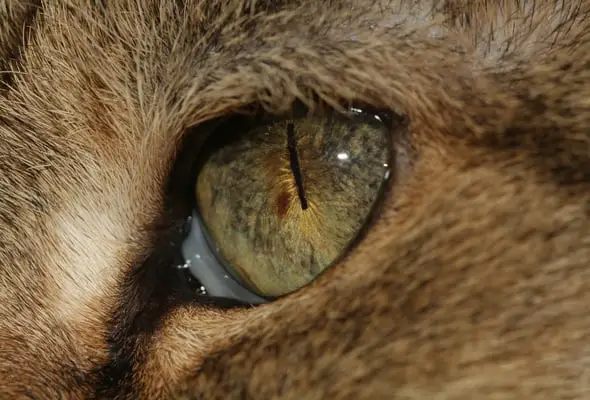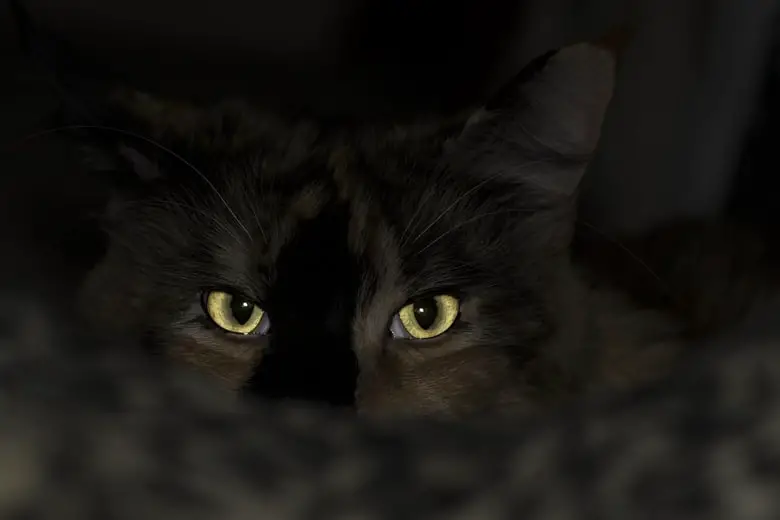Cats and kittens move with poise and stealth through dim light, leading many people to believe that they can see in the dark. As predatory animals, they certainly have to be able to navigate their environment confidently and with a keen awareness of their surroundings, seeing without themselves being seen. How do they do this? Can kittens see in the dark?
Can Kittens See In the Dark?
Although kittens do have good eyesight, they cannot see in the dark. However, the answer is more complicated than that. While kittens can’t see in complete darkness, they do have incredible night vision, which allows them to see better in low light.
The fact that they can still make out their surroundings in low light conditions has convinced many people that kittens can see in the dark. By the same token, what may look like complete darkness to us as humans may in fact contain more light than we can make out.
While kittens can see better at night than we can, like most other juvenile and infant mammals, kittens cannot see as well as their adult counterparts, and will not be able to maneuver as well in low light conditions as fully mature adult cats.
Now that we’ve distinguished between a kitten’s inability to see in complete darkness and its ability to see in low light conditions, we can clarify our original question and amend it slightly by instead asking how kittens are able to see in low light.
How Can Kittens See in Low Light?
As we stated a second ago, cat’s are adept and efficient hunters equipped with many features that aid them when stalking and hunting prey. Perhaps their most useful tool when on the hunt is their eyesight, which allows them to perceive things that we as humans are unable to pick up on or notice.
To effectively answer how their eyes are able to do this, we have to turn to science and look towards the structural differences between cat eyes and human eyes. For starters, if you’ve ever looked into a cat’s eyes, you’ll have noticed that its pupils are shaped differently than our own.
While our own pupils are round, a cat’s eyes can sometimes appear as slits, and other times as widening circles. The elliptical shape of a cat’s eye allows it to be opened and closed like the aperture on a camera, effectively controlling the amount of light entering the pupil.
For context on why its eyes do this, a cat’s eyes narrow to slits when exposed to bright sunlight, blocking excess light from entering the pupil.
At night, when the light is low, the vertical slit expands to become a wide circle, increasing in surface area to allow as much light as possible into the pupil. The more light filtering in, the better a cat is able to see.
However, this is not the only reason cats can see well at night. In addition to the shape of their pupil, a cat’s eye contains a greater number of rod cells than human eyes. In fact, they contain about six times as many rod cells.
What are Rod Cells and How do They Help Kittens See at Night?
Rod cells are one of two types of photoreceptive cells that can be found in the eyes of mammals, with the other type of cell being cone cells. As the name suggests, rod cells are named for their elongated shape.
Rod cells are incredibly sensitive and can pick up on the light emitted by even a single photon. When struck by light reflected off an object, rod cells transmit this information to the brain which converts the reflected light into an image.
These cells occur in the eyes of all mammals, although the number of rod cells varies greatly from species to species.
While rod cells are ultra sensitive to light, they are less effective at sensing movement and color than cone cells. You have probably experienced this phenomenon yourself when trying to see at night.
Colors are less clear, and fast moving objects often lack clarity. This should help you understand that even though a kitten can see better at night than you can, its night vision is not as clear as you might think.
Even so, the sheer quantity of rod cells in a kitten’s eye allow it to pick up on even the subtlest visual stimuli under extremely low light conditions.
Why can Kittens See at Night?
Now that we’ve addressed how kittens can see well at night, it is also important to question why they can do so. The answer relates less to the nature of a kitten’s eyes than it does to environmental and behavioral factors that necessitated night vision in cats.

Like most predatory mammals, cats rely on their stealth and agility to catch unwitting prey. This is no easy feat. No animal wants to be another animal’s lunch. Because of this, most prey animals have developed traits and habits to elude predators like cats, making it a challenge for cats to chase down and capture them.
To get around this, cats and other predators have adopted nocturnal hunting practices, allowing them to search out and stalk prey unawares. As most prey animals are grazers or foragers, they spend their days eating and their nights sleeping. As such, many prey animals also see less well at night.
Keen night vision gives cats the upper hand, allowing them to silently maneuver around their prey without detection. Once in position, the cat springs on the unwitting prey, securing its next meal.
More than just for giving cats the element of surprise on the offensive, their ability to see well in low light also enables cats to perceive and evade predators that would otherwise hunt them at night as well.
Conclusion
As we’ve learned, kittens are unable to see in complete darkness. That being the case, you now know that they are able to see well in especially low light, detecting objects and movements that would otherwise escape our notice. Two factors in the biology of cats enable them to do this.
The first is the flexibility of their pupil, which expands and contracts to control the amount of light filtering through the retina, while the second is the abundance of rod cones in a cat’s eye, which are the sensory cells that allow mammals to see under low light conditions.
This superpower is useful in more ways than one, allowing cats not only to surprise and capture prey, but also to avoid becoming prey themselves. The latter is especially important in the case of kittens, as they are less agile than adult cats and are poorly equipped to defend themselves.
For kittens, being able to sense a nocturnal threat helps them elude danger and survive into adulthood.


